celeba数据集_轻松学 Pytorch 使用DCGAN实现数据复制
点击上方蓝字关注我们微信公众号:OpenCV学堂关注获取更多计算机视觉与深度学习知识DCGANIan J. Goodfellow首次提出了GAN之后,生成对抗只是神经网络还不是深度卷积神经网络,所以有人提出一种基于深度神经网络的生成对抗网络,这个就是DCGAN。相比之前的GAN,DCGAN在生成者与判别者网络上的改进如下:1.使用步长卷积与反卷积替代池化实现上下采样2.在生成者与判别者网...
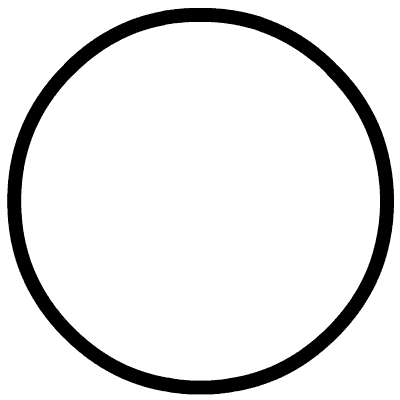
点击上方蓝字关注我们
微信公众号:OpenCV学堂
关注获取更多计算机视觉与深度学习知识
DCGAN
Ian J. Goodfellow首次提出了GAN之后,生成对抗只是神经网络还不是深度卷积神经网络,所以有人提出一种基于深度神经网络的生成对抗网络,这个就是DCGAN。相比之前的GAN,DCGAN在生成者与判别者网络上的改进如下:
1.使用步长卷积与反卷积替代池化实现上下采样2.在生成者与判别者网络使用BN层3.删除全链接层4.在生成者网络使用ReLU作为激活函数,最后一层使用tanh5.在判别者网络使用LeakyReLU作为激活函数生成者网络如下:
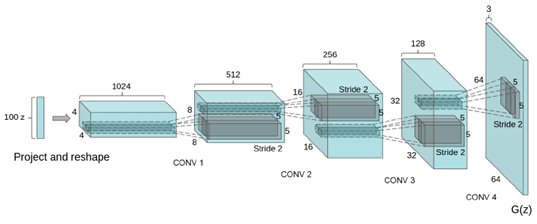
使用celebA人脸数据集,20W张人脸数据,完成DCGAN的训练,最终保存生成者模型。下面是DCGAN的代码实现与,训练与基于生成者实现人脸数据的复制。
DCGAN代码实现与训练
01
生成者
生成者卷积神经网络的代码实现如下:
class Generator(nn.Module): def __init__(self, ngpu): super(Generator, self).__init__() self.ngpu = ngpu self.main = nn.Sequential( # input is Z, going into a convolution nn.ConvTranspose2d(nz, ngf * 8, 4, 1, 0, bias=False), nn.BatchNorm2d(ngf * 8), nn.ReLU(True), # state size. (ngf*8) x 4 x 4 nn.ConvTranspose2d(ngf * 8, ngf * 4, 4, 2, 1, bias=False), nn.BatchNorm2d(ngf * 4), nn.ReLU(True), # state size. (ngf*4) x 8 x 8 nn.ConvTranspose2d( ngf * 4, ngf * 2, 4, 2, 1, bias=False), nn.BatchNorm2d(ngf * 2), nn.ReLU(True), # state size. (ngf*2) x 16 x 16 nn.ConvTranspose2d( ngf * 2, ngf, 4, 2, 1, bias=False), nn.BatchNorm2d(ngf), nn.ReLU(True), # state size. (ngf) x 32 x 32 nn.ConvTranspose2d( ngf, nc, 4, 2, 1, bias=False), nn.Tanh() # state size. (nc) x 64 x 64 ) def forward(self, input): return self.main(input)02
判别者
判别者卷积神经网络代码实现如下:
1class Discriminator(nn.Module):
2 def __init__(self, ngpu):
3 super(Discriminator, self).__init__()
4 self.ngpu = ngpu
5 self.main = nn.Sequential(
6 # input is (nc) x 64 x 64
7 nn.Conv2d(nc, ndf, 4, 2, 1, bias=False),
8 nn.LeakyReLU(0.2, inplace=True),
9 # state size. (ndf) x 32 x 32
10 nn.Conv2d(ndf, ndf * 2, 4, 2, 1, bias=False),
11 nn.BatchNorm2d(ndf * 2),
12 nn.LeakyReLU(0.2, inplace=True),
13 # state size. (ndf*2) x 16 x 16
14 nn.Conv2d(ndf * 2, ndf * 4, 4, 2, 1, bias=False),
15 nn.BatchNorm2d(ndf * 4),
16 nn.LeakyReLU(0.2, inplace=True),
17 # state size. (ndf*4) x 8 x 8
18 nn.Conv2d(ndf * 4, ndf * 8, 4, 2, 1, bias=False),
19 nn.BatchNorm2d(ndf * 8),
20 nn.LeakyReLU(0.2, inplace=True),
21 # state size. (ndf*8) x 4 x 4
22 nn.Conv2d(ndf * 8, 1, 4, 1, 0, bias=False),
23 nn.Sigmoid()
24 )
25
26 def forward(self, input):
27 return self.main(input)03
模型训练
初始化与模型训练
1# Create the Discriminator
2netD = Discriminator(ngpu).to(device)
3
4# Handle multi-gpu if desired
5if (device.type == 'cuda') and (ngpu > 1):
6 netD = nn.DataParallel(netD, list(range(ngpu)))
7
8# Apply the weights_init function to randomly initialize all weights
9# to mean=0, stdev=0.2.
10netD.apply(weights_init)
11
12# Print the model
13print(netD)
14
15
16# Initialize BCELoss function
17criterion = nn.BCELoss()
18
19# Create batch of latent vectors that we will use to visualize
20# the progression of the generator
21fixed_noise = torch.randn(64, nz, 1, 1, device=device)
22
23# Establish convention for real and fake labels during training
24real_label = 1.
25fake_label = 0.
26
27# Setup Adam optimizers for both G and D
28optimizerD = optim.Adam(netD.parameters(), lr=lr, betas=(beta1, 0.999))
29optimizerG = optim.Adam(netG.parameters(), lr=lr, betas=(beta1, 0.999))
30
31
32# Training Loop
33
34# Lists to keep track of progress
35img_list = []
36G_losses = []
37D_losses = []
38iters = 0
39
40if __name__ == "__main__":
41 print("Starting Training Loop...")
42 # For each epoch
43 for epoch in range(num_epochs):
44 # For each batch in the dataloader
45 for i, data in enumerate(dataloader, 0):
46
47 ############################ 48 # (1) Update D network: maximize log(D(x)) + log(1 - D(G(z))) 49 ###########################
50 ## Train with all-real batch
51 netD.zero_grad()
52 # Format batch
53 real_cpu = data[0].to(device)
54 b_size = real_cpu.size(0)
55 label = torch.full((b_size,), real_label, dtype=torch.float, device=device)
56 # Forward pass real batch through D
57 output = netD(real_cpu).view(-1)
58 # Calculate loss on all-real batch
59 errD_real = criterion(output, label)
60 # Calculate gradients for D in backward pass
61 errD_real.backward()
62 D_x = output.mean().item()
63
64 ## Train with all-fake batch
65 # Generate batch of latent vectors
66 noise = torch.randn(b_size, nz, 1, 1, device=device)
67 # Generate fake image batch with G
68 fake = netG(noise)
69 label.fill_(fake_label)
70 # Classify all fake batch with D
71 output = netD(fake.detach()).view(-1)
72 # Calculate D's loss on the all-fake batch
73 errD_fake = criterion(output, label)
74 # Calculate the gradients for this batch
75 errD_fake.backward()
76 D_G_z1 = output.mean().item()
77 # Add the gradients from the all-real and all-fake batches
78 errD = errD_real + errD_fake
79 # Update D
80 optimizerD.step()
81
82 ############################ 83 # (2) Update G network: maximize log(D(G(z))) 84 ###########################
85 netG.zero_grad()
86 label.fill_(real_label) # fake labels are real for generator cost
87 # Since we just updated D, perform another forward pass of all-fake batch through D
88 output = netD(fake).view(-1)
89 # Calculate G's loss based on this output
90 errG = criterion(output, label)
91 # Calculate gradients for G
92 errG.backward()
93 D_G_z2 = output.mean().item()
94 # Update G
95 optimizerG.step()
96
97 # Output training stats
98 if i % 50 == 0:
99 print('[%d/%d][%d/%d]\tLoss_D: %.4f\tLoss_G: %.4f\tD(x): %.4f\tD(G(z)): %.4f / %.4f'
100 % (epoch, num_epochs, i, len(dataloader),
101 errD.item(), errG.item(), D_x, D_G_z1, D_G_z2))
102
103 # Save Losses for plotting later
104 G_losses.append(errG.item())
105 D_losses.append(errD.item())
106
107 # Check how the generator is doing by saving G's output on fixed_noise
108 if (iters % 500 == 0) or ((epoch == num_epochs-1) and (i == len(dataloader)-1)):
109 with torch.no_grad():
110 fake = netG(fixed_noise).detach().cpu()
111 iters += 1
112
113 # save model
114 netG.eval()
115 torch.save(netG, 'generate_model.pt')请大家原谅我,因为我比较懒,就直接把pytorch官方教程中的代码,经过一番粘贴复制然后一通猛改就成了这个例子了!所以注释都是英文的,大家自己慢慢看吧,基于celebA人脸数据集训练,我的机器是GTX1050Ti,所以只训练了3个epoch就over了,主要是为了省电跟环保@_@!然后保存了生成者模型。
模型使用
基于DCGAN的生成者模型,直接加载,生成100个随机数作为输入样本,生成的人脸图像如下:
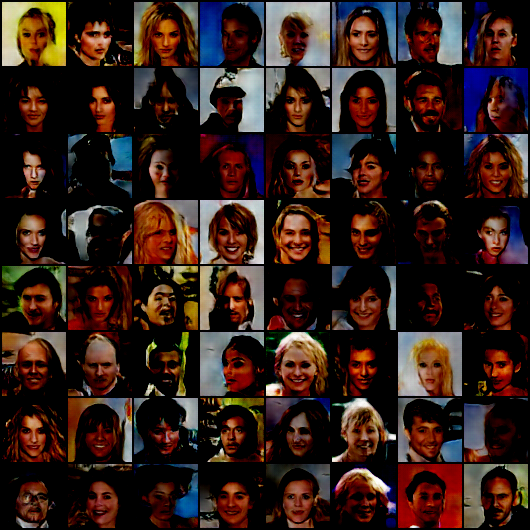
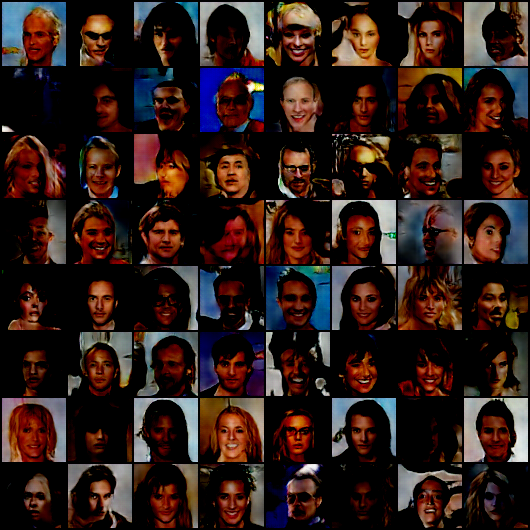
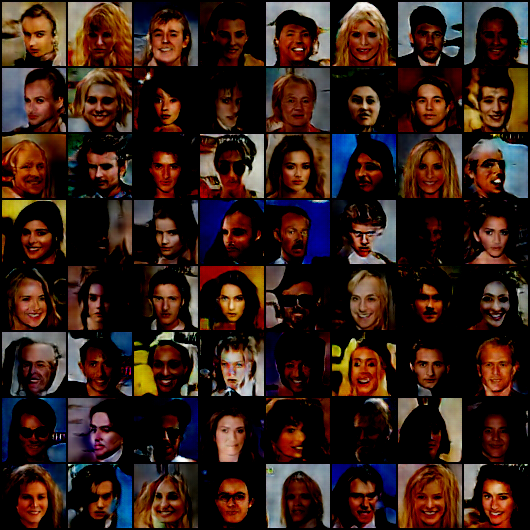
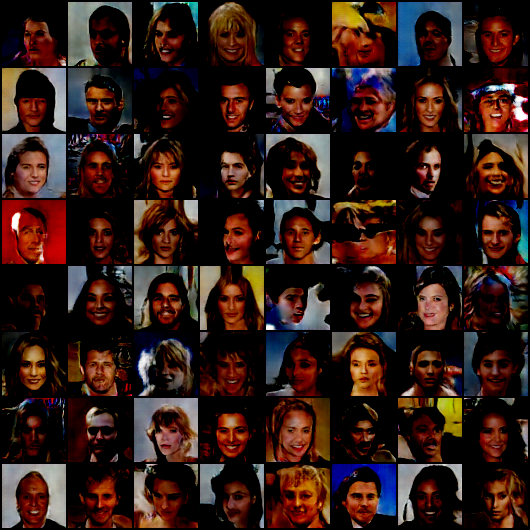
从上图可以看出已经有点效果了,感兴趣可以继续训练,演示代码如下:
1import torch
2import cv2 as cv
3import numpy as np
4from dcgan_model import Generator
5from torchvision.utils import save_image
6
7
8def dcgan_generate_face_demo():
9 netG = torch.load("./generate_model.pt")
10 netG.cuda()
11 for i in range(4):
12 noise = torch.randn(64, 100, 1, 1, device="cuda")
13 # Generate fake image batch with G
14 generated = netG(noise)
15 print(generated.size())
16 save_image(generated.view(generated.size(0), 3, 64, 64), 'D:/sample_%d'%i + '.png')
17
18
19if __name__ == "__main__":
20 dcgan_generate_face_demo()君子藏器于身,待时而动
推荐阅读
OpenCV4系统化学习路线图-视频版本!
Tensorflow + OpenCV4 安全帽检测模型训练与推理
汇总 | OpenCV DNN模块中支持的分类网络
OpenCV中支持的人脸检测方法整理与汇总
详解ENet | CPU可以实时的道路分割网络
从Pytorch 的ONNX到OpenVINO中IR中间层
OpenVINO中的FCOS人脸检测模型代码演示
详解OpenVINO 模型库中的人脸检测模型
效果特好 | OpenVINO手写数字识别
OpenVINO+OpenCV 文本检测与识别
OpenVINO + OpenCV实现点头与摇头识别验证
OpenVINO + OpenCV实现车辆检测与道路分割
OpenCV二值图像分析之寻找缺失与靶心
OpenCV 基于Inception模型图像分类
OpenCV4.4 + YOLOv4 真的可以运行了…..
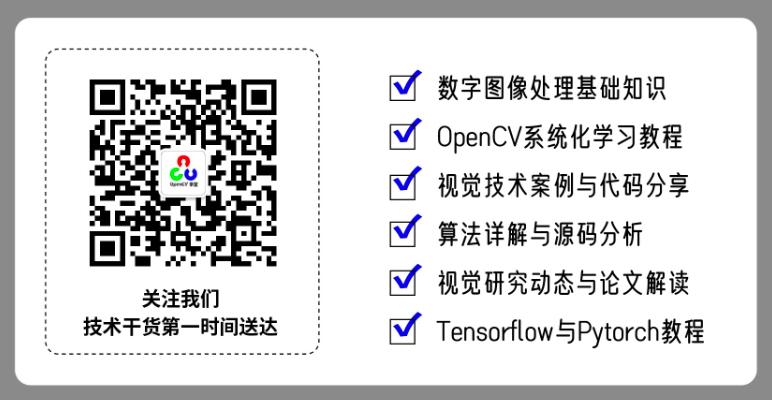

魔乐社区(Modelers.cn) 是一个中立、公益的人工智能社区,提供人工智能工具、模型、数据的托管、展示与应用协同服务,为人工智能开发及爱好者搭建开放的学习交流平台。社区通过理事会方式运作,由全产业链共同建设、共同运营、共同享有,推动国产AI生态繁荣发展。
更多推荐
 已为社区贡献1条内容
已为社区贡献1条内容








所有评论(0)